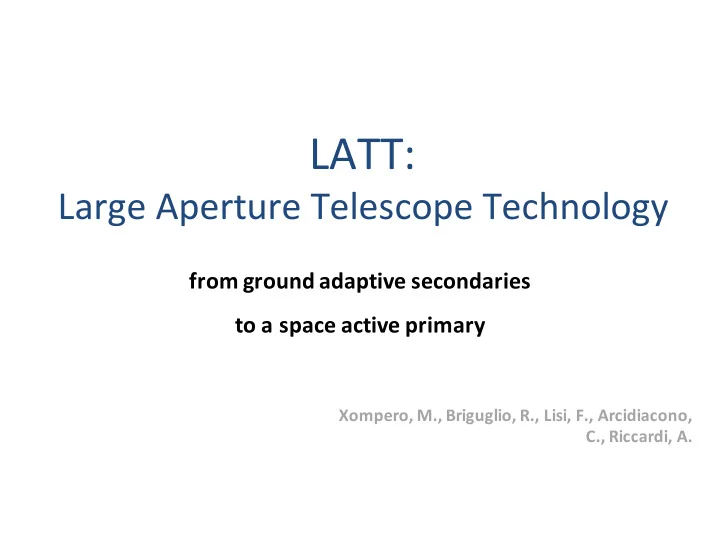

LATT: Large Aperture Telescope Technology from ground adaptive secondaries to a space active primary Xompero, M., Briguglio, R., Lisi, F., Arcidiacono, C., Riccardi, A.
The LATT Team CGS S.p.A.: coordinator C.Vettore, F. Duo D.Gallieni, M.Tintori, P.Lazzarini ADS International: mech. System MICROGATE: electr.+control R. Biasi, C.Patauner systems+testing INO CNR-INO Italian Optics Inst.: shell F. D’Amato, M. Pucci INAF-Italian Astrophysics Inst.: R. Briguglio, M. Xompero, A. Riccardi, F. Lisi AO expertise+optical testing ’ L. Maresi, A. Zuccaro Marchi, J. ESA Pereira do Carmo
LATT? Concept and demonstrator • Is our response to the needs of space mirrors: • Large format • Possibly deployable/segmented Preliminary study: • Lightweighted * ALC project in 2007 • Actively shaped LATT prototyping: * ESTEC/Contract No. • Scientific cases 22321/09/NL/RA • Astronomical telescope Expertise from LBT672, DSM, M4DP: • LIDAR Technologies, strategies, • Earth monitoring procedures • Telecommunications
Actually our secret goal was to fix the ESA logo!!! LATT can handle it!
Project status • Ended in october 2015 with final review @ESA-ESTEC: • Lightweigth: better than JWST • Actuator stroke >> competitors • Power consumption: almost negligible • Concept: very attractive for future developments • Presented at Space Active Optics @ESTEC (nov.2015) • Unique of large format, deformable • Unique concept addressing segmentation • Unique applicable to primary mirror concept
LATT: 400mm, F/6 sphere, 19 acts • CFRP+Al honeycomb Reference Body (<9 kg/m2) • Co-located, contactless, position capacitive sensors (8 nm precision ) • Contactless, voice-coil motors (<55mW, 1mm stroke, , ± 0.24 N and 0.08N for flat) • Low print-through glued magnet (19 acts) 400 mm • Thin glass shell ( 400mm diam x 1 mm th., F/6 ) • 1 single cable, 1 small electronics box (15W) (providing local control loop and launch safety mechanism for the thin shell)
From adaptive secondaries to a space active primary ? LBT: ellipt. 1 m, 672 acts, kW, 1kHz LATT: spher . 0.4 m, 19 acts, 1W, 1Hz VLT: asph . 1.2 m, 1170 acts, kW, 1kHz & new hair cap, ton sur ton
Solutions validated, towards TRL 5 • Shell electrostatic locking: The shell is electrically ‘glued’ on the RefBodyduring launch Reduced power consumption • Contactless, voice-coil motors (<55mW, 1mm stroke) Low bandwith smartactuators Goal optical quality •
Solutions validated, towards TRL 5 • Shell electrostatic locking: The shell is electrically ‘glued’ on the RefBodyduring launch Reduced power consumption • Contactless, voice-coil motors (<55mW, 1mm stroke) Low bandwith smartactuators Goal optical quality •
Solutions validated, towards TRL 5 • Shell electrostatic locking: The shell is electrically ‘glued’ on the RefBodyduring launch Reduced power consumption • Contactless, voice-coil motors (<55mW, 1mm stroke) Low bandwith smartactuators Goal optical quality • Stabilitychecked • Comparable with ground • based technology: flattened 30 nm RMS WFE
LATT - integration Actuator cups mounted on the Reference body front surface with aluminum honeycomb capacitive sensor Shell mounted on the reference body Actuator magnets glued on the shell
Laboratory test campaign Thermal test Thermo-vacuum test Optical test Tested @ 1e-5mbar Temperature range: -25°C à 55°C Vibration test Electrostatic locking test WFE comparable with AO after removing the membranes deformation ( λ /6 @UV) 12 locking pressure: 600 N/m2 Max acceler.: 10g
LATT scaling: from secondary to primary • @same optical area: • Larger actuator density is feasible (no optical compression) • Lower print-through (dispersed on larger area) p’ • @same actuator density: • Larger correction range (lower local stiffness: p vs p’) • Lower power-budget (lower local stiffness) • Easier manufacturing, no miniaturization p 13
Why a LATT-like primary mirror is attractive • 2 in 1: active element + lightweight < 22kg/m 2 • low areal density compared to existing systems • no need to develop novel lightweight technologies • No relay, no additional optics, simple design • Very low power consumption • <55mw for each act • 15W for control electronics • Natural solution for segmented mirrors • Alignment+phasingallocated to active optics • Act stroke & accuracy relax deployment tolerances • Complex mirror topology: local correction is easier 14 ESTEC/Contract No. 22321/09/NL/RA
Conclusion • Thin shell + voice coil acts + capac.sensors: well established technology for AO mirrors • LATT: • Spherical primary mirror, 40cm diam, F/6 • 19 acts, 55mW/act • CFRP+AL honeycomb+ thin zerodur shell: <22kg/m 2 • LATT demonstrated its applicability to space: • lightweight shell launch stresses • Low power budget shell controllability • LATT demonstrated the concept of: • Active + lightweight space primary (2 in 1) • Suitable to segmented/deployable systems
LATT: a brick for more complex systems 1m, 7 segments LATT OBB: 40 cm, 19 acts 3-5m, segmented 1m, monolithic
Recommend
More recommend